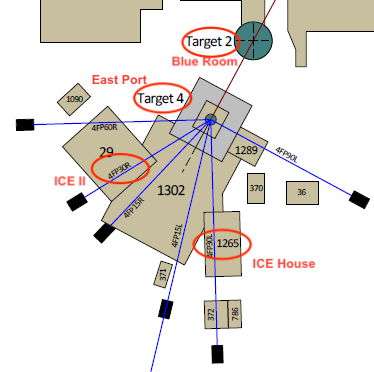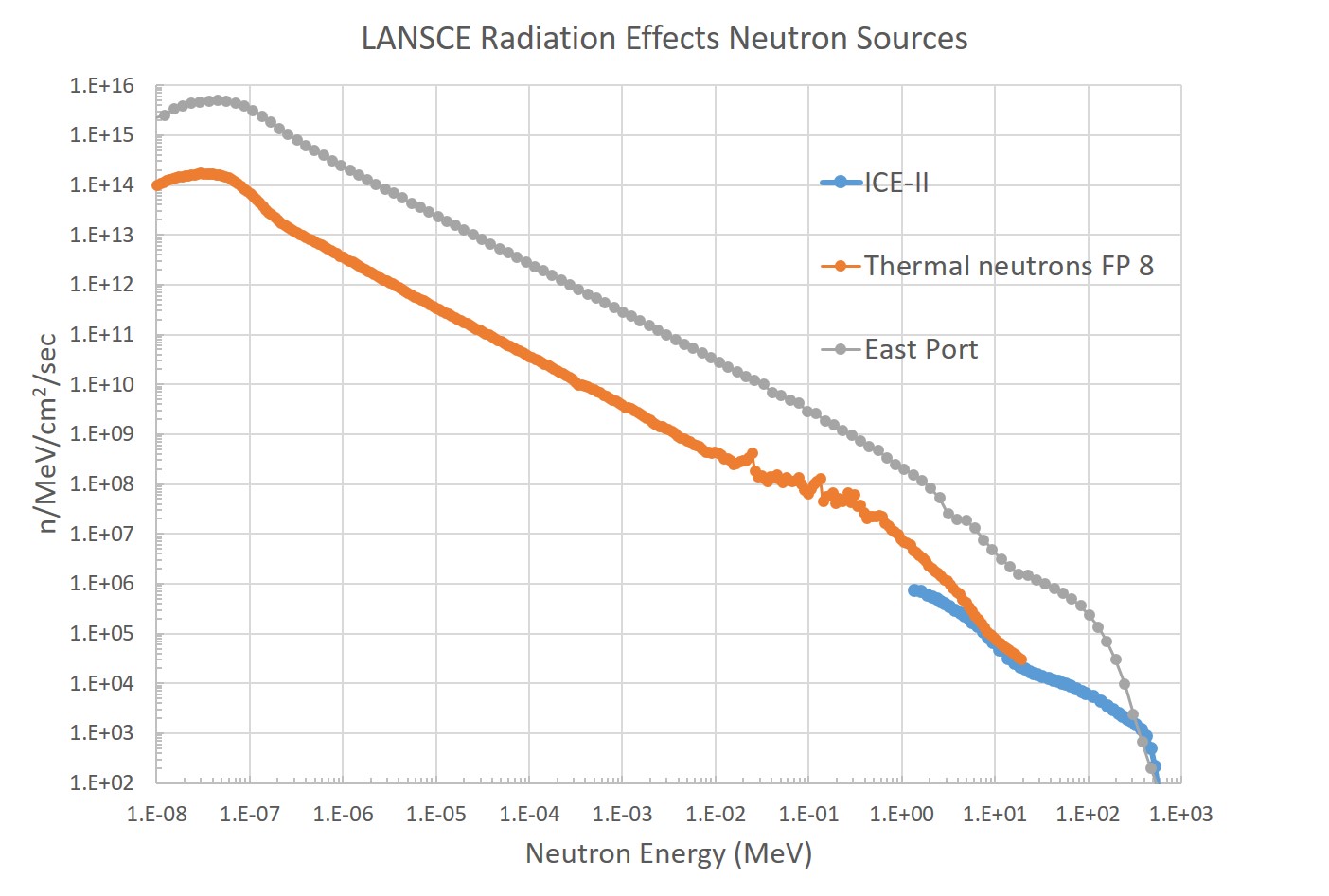LANSCE Radiation Effects Facilities
LANSCE Radiation Effects Facilities
The LANSCE accelerator has several experimental facilities that can be used for a wide range radiation effects research. These include radiation effects on semiconductor electronics, materials and biological systems. The facilities listed below are each optimized for a particular particle and energy range. Figure 1 shows the location of these facilities.
- ICE House and ICE-II
- East Port Irradiation Facility
- Target 2 (Blue Room)
- Thermal Neutrons (under developement)
- 60R Flight Path (under developement)
- Proton Beam Line in Area A (under developement)
For more information about these facilities, click on the name of the facility below or on the right hand menu.

Figure 1 WNR Flight Paths Schemantic

Figure 2 Shape of the Neutron Spectrum at LANSCE
ICE House and ICE-II
The ICE House and ICE-II are two high-energy neutron flight paths at + / – 30o from the proton beam off of Target 4. The neutron spectrum on these flight paths is very similar to the terrestrial neutron spectrum produced by cosmic rays hitting the atmosphere and ranges from approximately 1 MeV up to approximately 600 MeV. The integrated neutron flux above 1 MeV on these flight paths are approximately 5 x 106 neutrons/cm2/sec. The shape of the neutron spectrum is shown in Figure 2. Many industry, laboratory and university researchers used this facility to qualify and test semiconductor devices for single-event effects.
East Port Irradiation Facility
This facility provides an intense neutron flux for material irradiation research. The samples are located near the Target 4 production target but not in the direct field of view of the tungsten target. This produces a neutron spectrum as shown in Figure 2. This facility would be used mostly for materials irradiation research because of the time required to access the samples and no capability at this time for real-time experiments. The integrated intensity from approximately 1.4 MeV to 600 MeV is 6 x 109 neutrons/cm2/sec.
Target 2 (Blue Room)
Target 2 is a large (~12m diameter) experimental area which has access to the proton beam. The energy of the proton beam can range from 800 MeV down to approximately 250 MeV. Access to this area is limited because its use precludes operation of Target 4 and if operated at other than 800 MeV, it also shuts down the Lujan Center beam. Average proton currents up to 80 nA (5x 1011 protons/sec) are possible. In addition intense pulses (3x 1013 protons/pulse) from the proton storage ring can be delivered to this area.For more details on the time structure, visit the Target 2 webpage.
Planned Upgrades and Future Capabilities
Thermal Neutrons at Lujan Center
We are proposing to develop a room temperature thermal neutron flight path at the Lujan Center (Target 1) for thermal neutron testing and research. At this time, it appears that Flight Path 8 would be the best candidate for such a flight path because it has high intensity, easy access and relatively easy installation. The shape of the neutron spectrum is shown in Figure 2 and the thermal neutron intensity is approximately 2x 107 n/cm2/sec. Flight Path 8 is in planning. Please provide support and interest to the Instrument Scientists.
60R Flight Path
The 60R flight path is a high-energy neutron flight path at 60 degrees to the right of the proton beam off Target 4. The neutron spectrum of this flight path ranges from approximately 1 MeV to approximately 400 MeV, and it is shown in Figure 3.

Figure 3 The neutron flux in units of neutrons/MeV/cm2/sec in the ICE House and in the 60R experimental areas. The flux is calculated 21 m away from the neutron production target.
The integrated neutron flux above 1 MeV on this flight path, 21 m away from the production target, is approximately 3x106 neutrons/cm2/sec. We are planning to upgrade this flight path to provide the same level of support to users as the two ICE Houses. This flight path should provide additional capacity for radiation effects users who can use a neutron spectrum that is not as closely matched to the atmospheric neutron spectrum provided in the ICE House flight paths.
Proton Flight Path
We are proposing to develop a proton flight path for testing and research. The energy of the proton beam will range from 800 MeV down to approximately 250 MeV, and the proton current will be approximately 100 nA (6x 1011 protons/sec). The protons will be delivered in pulses less than 1ns wide. This capability will be similar to the Target-2 capability except it should be more available for users.

